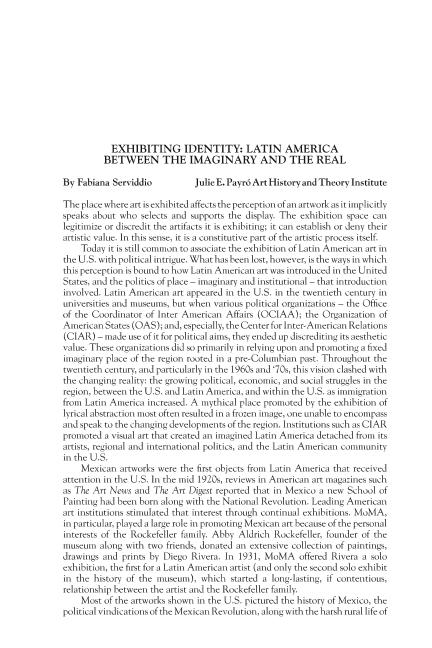Artículo
Exhibiting identity: Latin America between the imaginary and the real
Fecha de publicación:
01/12/2010
Editorial:
Oxford University Press
Revista:
Journal Of Social History
ISSN:
0022-4529
e-ISSN:
1527-1897
Idioma:
Inglés
Tipo de recurso:
Artículo publicado
Clasificación temática:
Resumen
The place where art is exhibited affects the perception of an artwork as it implicitly speaks about who selects and supports the display. The introduction of Latin American art in the United States is bound to the political aims pursued by the organizations that carried on this project: the Office of the Coordinator of Inter American Affairs (OCIAA), in the 1940s; the Organization of American States (OAS), during the Cold War; and, especially, the Center for Inter-American Relations (CIAR), in the 1970s. Because art was being used as a political vehicle to improve relations between culturally detached regions, these initiatives favored artworks that more easily entered into an already fixed and pre-established identity pattern. The selected artworks promoted a stereotyped image of Latin America as a place untouched by modernity, or a magical site linked to the pre-Columbian past. By the 1970s, however, artworks exhibited the complexity and impossibility of identity fixations and definitions about what was Latin America. Interested in dealing with the convulsive reality of the region, artists made full use of international languages, and doing so they exposed all the institutional initiatives that had manipulated the place of art and its representations for political purposes.
Palabras clave:
LATINOAMERICA
,
EXHIBICION
,
IDENTIDAD
,
IMAGINARIO
Archivos asociados
Licencia
Identificadores
Colecciones
Articulos(SEDE CENTRAL)
Articulos de SEDE CENTRAL
Articulos de SEDE CENTRAL
Citación
Serviddio, Luisa Fabiana; Exhibiting identity: Latin America between the imaginary and the real; Oxford University Press; Journal Of Social History; 44; 2; 1-12-2010; 481-498
Compartir
Altmétricas




